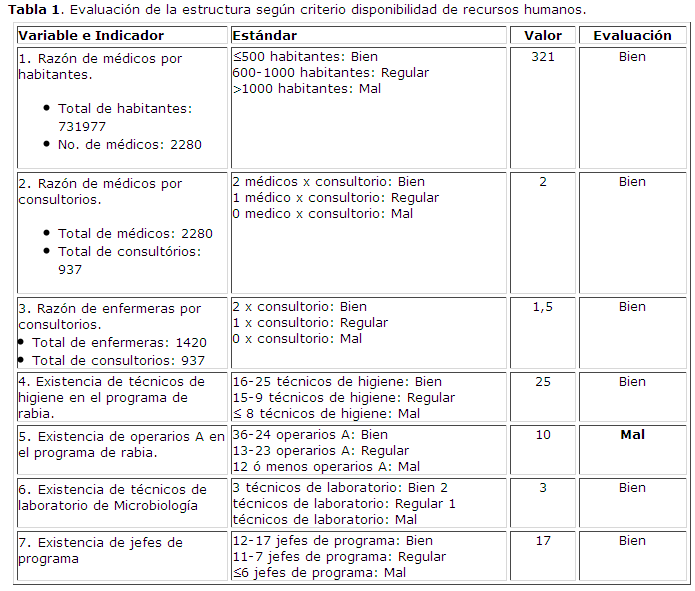Evaluation of Rabies National Program, Pinar del Río Province (2010)
Keywords:
Rabies, Disease prevention.Abstract
Introduction: the evaluation is conceived as the activity permitting to deliver judgments of value, to identify the gaps existing between the achievement of the goals and its behavior in a certain time, and the further proposal of measures for correction.Objective: to evaluate its components structure, process, and results.
Material and methods: an evaluative revision of the rabies program was made in Pinar del Río Province in 2010. The information was collected by papers research, observation of processes, interviews with the human resources involved in the program; as synthetic means we used absolute frequencies, rates, and percentages. The criteria, indicators and standards were defined under normative and expert criteria.
Results: the dimension structure was evaluated as inadequate, as it does not comply by the proposed standards. In the dimension process, the 66.6% of the examined indicators were evaluated as wrong or fair. The 66.6% of the indicators of the dimension results of the program were evaluated as wrong. Conclusions: the Rabies Program was evaluated as wrong.
Downloads
References
1. Toledo GJ. Fundamentos de Salud Pública T1. Ciencias Médicas: La Habana; 2004. Pág. 128-34,330-77
2. Valencia M, Salazar JC, Correa JC. Evaluación de cambios en el nivel de depresión de usuarios de un programa de bienestar. Rev. salud pública. [Internet] Bogotá. Colombia. Julio/Agosto. 2011. [Consultado el 20 de febrero de 2012]; 13 (4). En http://www.scielo.org.co/scielo.php?script=sci_arttext&pid=S0124-00642011000400011&lang=pt
3. Pérez R, Santín M, Cruz R. Programa Nacional de Prevención y Control de la Rabia. (3ra. Versión). La Habana: Ministerio de Salud Pública; 1997.
4. Valdez L. Enfermedades emergentes y reemergentes. Ed. Ciencias Médicas. La Habana, 2008: Pág. 206-214.
5. Medina L, Plasencia J, Medina T, Pérez MA. Evaluación del programa de prevención y control de la Rabia. Provincia Sancti Spíritus. 2009. Gaceta Médica Espirituana [Internet]. 2011 [Consultado el 12/3/2012]; 13(3). Disponible en http://www.bvs.sld.cu/revistas/gme/pub/vol.13.(3)_03/p3.html
6. Arnold Y, Chapi Y, Díaz A, Rodríguez S, Trimiño AA. Evaluación del programa de Control Sanitario Internacional en el policlínico Nguyen Van Troi de Centro Habana. La Habana. [ 2007. Rev. Cubana Hig Epidemiol [Internet] 2011. [Consultado el 6 de junio de 2012]; 49(2). Disponible en: http://scielo.sld.cu/scielo.php?pid=S1561-30032011000200009&script=sci_arttext&tlng=en
7. Paredes C, Navarro AM, Juárez V, Schneider C, Leanes L, Cárdenas J, et al. Evaluación del Programa Nacional de Rabia de Colombia: OPS; 2005.
8. López R, Díaz A, Condori E. Susceptibilidad canina a Rabia después de una campaña de vacunación en zonas endémicas del Perú. Rev. Perú Med Exp Salud Pública [Internet]. 2007. [Consultado el 12 de marzo de 2010]; 24 (1). Disponible en http://www.scielo.org.pe/scielo.php?script=sci_arttext&pid=S1726-46342007000100003&lng=es&nrm=iso&tlng=es
9. Cediel N, de la Hoz F, Villamil LC, Romero J, Díaz A. Epidemiología de la rabia canina en Colombia. Rev. Salud Pública [Internet] 2010 : 368-379. [Consultado el 6 de junio de 2012]; 12(3). Disponible en:
10. Pelayo S. Zooantroponosis. Ed. Ciencias Médicas. La Habana, 2008: Pág. 195-202.
11. Arredondo A, Amores J. Enfermedades reemergentes: factores causales y vigilancia. Rev. AMC [Internet] 2009. [Consultado el 12 de marzo de 2010]; 13(2). Disponible en http://scielo.sld.cu/scielo.php?script=sci_arttext&pid=S1025-02552009000200016&lng=en&nrm=iso&ignore=.html
12. Alemán Brunet MC, Guerra Rodríguez Y, Rodríguez Heredia O, Castañeda Souza A. Intervención educativa para elevar el nivel de conocimientos sobre rabia en adolescentes. AMC? [revista en la Internet]. 2012? Feb [citado? 2013? Ene? 28] ;? 16(1): 62-70. Disponible en: http://scielo.sld.cu/scielo.php?script=sci_arttext&pid=S1025-02552012000100008&lng=es

Published
How to Cite
Issue
Section
License
Authors who have publications with this journal agree to the following terms: Authors will retain their copyrights and grant the journal the right of first publication of their work, which will be publication of their work, which will be simultaneously subject to the Creative Commons Attribution License (CC-BY-NC 4.0) that allows third parties to share the work as long as its author and first publication in this journal are indicated.
Authors may adopt other non-exclusive license agreements for distribution of the published version of the work (e.g.: deposit it in an institutional telematic archive or publish it in a volume). Likewise, and according to the recommendations of the Medical Sciences Editorial (ECIMED), authors must declare in each article their contribution according to the CRediT taxonomy (contributor roles). This taxonomy includes 14 roles, which can be used to represent the tasks typically performed by contributors in scientific academic production. It should be consulted in monograph) whenever initial publication in this journal is indicated. Authors are allowed and encouraged to disseminate their work through the Internet (e.g., in institutional telematic archives or on their web page) before and during the submission process, which may produce interesting exchanges and increase citations of the published work. (See The effect of open access). https://casrai.org/credit/


